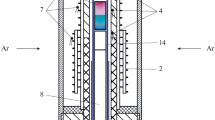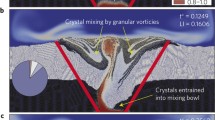Abstract
It has been demonstrated experimentally that basaltic and dacitic magmas can be easily mixed to form both banded dacite and homogeneous andesite in less than a few hours. The presence of phenocrysts larger than 0.5 mm increased considerably the efficiency of mixing. Flow patterns in the experimental system were visualized using Pt spheres, which indicated that convection occurs in basalt melt, but not in dacite melt. The Reynolds numbers of the basaltic and dacitic melts in the experimental system were calculated to be about 10−3 and 10−6, respectively. Mixing proceeds initially by mechanical mixing of the two magmas in a large scale, but later by coupling interfacial convection and mutual diffusion. Thus, depending on the depth where vesiculation and following disruption of the magma occurs, banded pumice, homogeneous pumice and homogeneous andesite lava are erupted. The observed textures of mixed rocks of Plinian type eruption and the limiting occurrence of banded pumice are satisfactorily accounted for on this model.
Similar content being viewed by others
References
Akashi T, Matsumi K, Okada T, Mizutani T (1969) Preparation of ferrite single crystals by new floating zone technique. IEEE Trans Magn MAG-5:285–289
Anderson AT (1976) Magma mixing: petrological process and volcanological tool. J Volcanol Geotherm Res 1:3–33
Bottinga Y, Weill DF (1972) The viscosity of magmatic silicate liquids: model for calculation. Am J Sci 272:438–475
Carlson A (1958) The fluid mechanics of crystal growth from solution. In: Doremus RH, Roberts BW, Turnbull D (eds) Growth and perfection of crystals. John Wiley & Sons, New York, pp 421–426
Donaldson CH, Brown RW (1977) Refractory megacrysts and magnesium-rich melt inclusions within spinel in oceanic tholeiites: Indicators of magma mixing and parental magma composition. Earth Planet Sci Lett 37:81–89
Dungan MA, Rhodes JM (1978) Residual glasses and melt inclusions in basalts from DSDP Legs 45 and 46: evidence for magma mixing. Contrib Mineral Petrol 67:417–431
Eichelberger JC (1975) Origin of andesite and dacite: evidence of mixing at Glass Mountain in California and other circum-Pacific volcanoes. Geol Soc Am Bull 86:1381–1391
Eichelberger JC (1978) Andesite volcanism and crustal evolution. Nature 275:21–27
Eichelberger JC (1980) Vesiculation of mafic magma during replenishment of silicic magma reservoirs. Nature 288:446–450
Fujimaki H, Aoki K (1980) Quantitative microanalyses of silicates, oxides and sulfides using an energy-dispersive type electron probe. Sci Rep Tohoku Univ Ser 3 14:261–268
Huppert HE, Sparks RSJ (1980a) Restrictions on the compositions of mid-ocean ridge basalts: a fluid dynamical investigation. Nature 286:46–48
Huppert HE, Sparks RSJ (1980b) The fluid dynamics of a basaltic magma chamber replenished by influx of hot, dense ultrabasic magma. Contrib Mineral Petrol 75:279–289
Huppert HE, Turner JS (1981) A laboratory model of a replenished magma chamber. Earth Planet Sci Lett 54:144–152
Huppert HE, Sparks RSJ, Turner JS (1982) Effects of volatiles on mixing in calc-alkaline magma systems. Nature 297:554–557
Huppert HE, Sparks RSJ, Turner JS (1983) Laboratory investigations of viscous effects in replenished magma chambers. Earth Planet Sci Lett 65:377–381
Kobayashi N, Wilcox WR (1982) Computational studies of convection due to rotation in a cylindrical floating zone. J Cryst Growth 59:616–624
Kouchi A, Sunagawa I (1982) Experimental study of mixing basaltic and dacitic magmas. Sci Rep Tohoku Univ Ser 3 14:163–175
Kouchi A, Sunagawa I (1983) Mixing basaltic and dacitic magmas by forced convection. Nature 304:527–528
Kouchi A, Sugawara Y, Kashima K, Sunagawa I (1983) Laboratory growth of sector zoned clinopyroxenes in the system CaMg-Si2O6-CaTiAl2O6. Contrib Mineral Petrol 83:177–184
Luhr JF, Carmichael ISE (1980) The Colima volcanic complex, Mexico I. Postcaldera andesites from volcan Colima. Contrib Mineral Petrol 71:343–372
Manfred H, Edger M (1979) Einsatz und Auslegung statischer Mischer. Chem Ing Tech 5:347–364
Nakagawa M (1983) Geology and Petrology of Moriyoshi volcano. J Jap Assoc Mineral Petrol Econ Geol 78:197–210
Rice A (1981) Convective fractionation: A mechanism to provide cryptic zoning (macrosegregation), layering, crescumulates, banded tuffs and explosive volcanism in igneous processes. J Geophys Res 86B:405–417
Sakuyama M (1979) Evidence of magma mixing: petrological study of Shirouma-Oike calc-alkaline andesite volcano, Japan. J Volcanol Geotherm Res 5:179–208
Sakuyama M (1981) Petrological study of Myoko and Kurohime volcanoes, Japan: crystallization sequence and evidence for magma mixing. J Petrol 22:553–583
Sakuyama M, Koyaguchi T (in press) Magma mixing in mantle xenolith-bearing calc-alkalic ejecta, Ichinomegata volcano, northeastern Japan. J Volcanol Geotherm Res
Sigurdsson H, Sparks RSJ (1981) Petrology of rhyolitic and mixed magma ejecta from the 1875 eruption of Askja, Iceland. J Petrol 22:41–84
Sparks RSJ, Sigurdsson H, Wilson L (1977) Magma mixing: a mechanism for triggering acid explosive eruptions. Nature 267:315–318
Turner JS, Huppert HE, Sparks RSJ (1983) An experimental investigation of volatile exsolution in evolving magma chambers. J Volcanol Geotherm Res 16:263–277
Walker D, Shibata T, DeLong SE (1979) Abyssal tholeiites from the Oceanographer Fracture Zone II: phase equilibria and mixing. Contrib Mineral Petrol 70:111–125
Watson EB (1982) Basalt contamination by continental crust: some experiments and models. Contrib Mineral Petrol 80:73–87
Yoder HS Jr (1973) Contemporaneous basaltic and rhyolitic magmas. Am Mineral 58:153–171
Yoder HS Jr, Tilley CE (1962) Origin of basalt magmas: an experimental study of natural and synthetic rock systems. J Petrol 3:342–532
Author information
Authors and Affiliations
Rights and permissions
About this article
Cite this article
Kouchi, A., Sunagawa, I. A model for mixing basaltic and dacitic magmas as deduced from experimental data. Contr. Mineral. and Petrol. 89, 17–23 (1985). https://doi.org/10.1007/BF01177586
Received:
Accepted:
Issue Date:
DOI: https://doi.org/10.1007/BF01177586




